Cause of death boat fire Name Andrew Downing | Role Landscaper Siblings Charles Downing | |
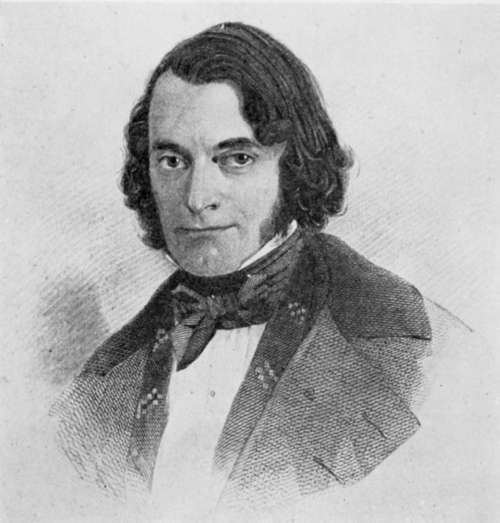 | ||
Books Landscape Gardening, The Fruits and Fruit Trees of, Rural Essays, A Treatise on the Theory a, A Treatise on the Theory a Structures Springside, Beechwood, Queset House, Utica Psychiatric Center, William G LeDuc House | ||
1832 N Meridian Drive Fayetteville AR
Andrew Jackson Downing (October 31, 1815 – July 28, 1852) was an American landscape designer, horticulturalist, and writer, a prominent advocate of the Gothic Revival in the United States, and editor of The Horticulturist magazine (1846–52). Downing is considered to be a founder of American landscape architecture.
Contents
- 1832 N Meridian Drive Fayetteville AR
- Early life
- Professional career
- Downings philosophy
- Architectural influence
- Early death
- Legacy
- Selected works
- References
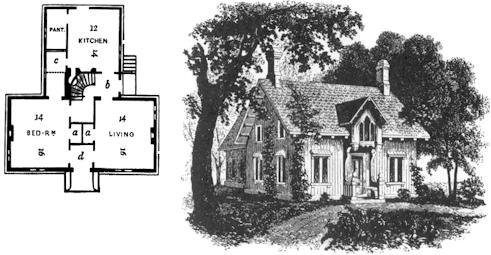
Early life
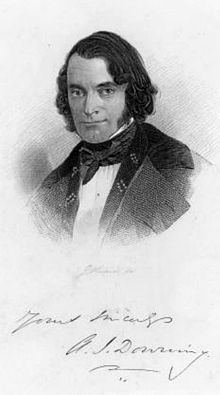
Downing was born in Newburgh, New York, United States, to Samuel Downing (a nurseryman and wheelwright) and Eunice Bridge. After finishing his schooling at 16, he worked in his father's nursery in the Town of Newburgh, and gradually became interested in landscape gardening and architecture. He began writing on botany and landscape gardening and then undertook to educate himself thoroughly in these subjects. He married Caroline DeWint in 1838.
Professional career
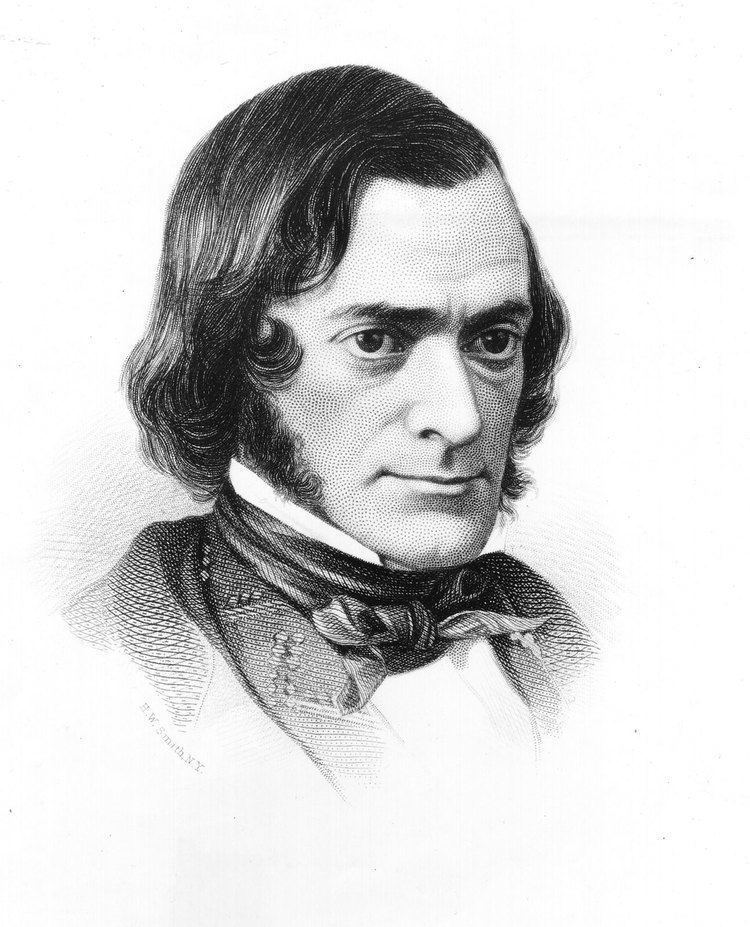
His official writing career started when he began writing articles for various newspapers and horticultural journals in the 1830s. In 1841 his first book, A Treatise on the Theory and Practice of Landscape Gardening, Adapted to North America, was published to a great success; it was the first book of its kind published in the United States.
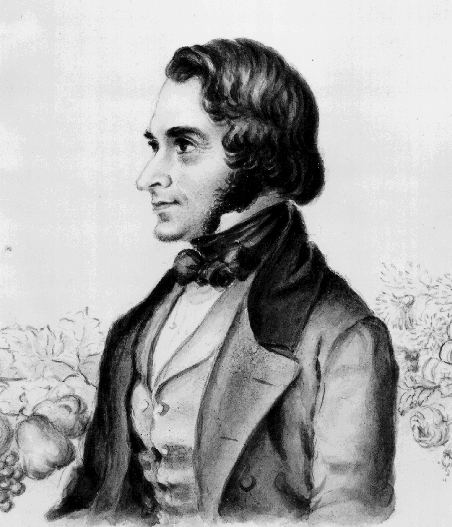
In 1842 Downing collaborated with Alexander Jackson Davis on the book Cottage Residences, a highly influential pattern book of houses that mixed romantic architecture with the English countryside's pastoral picturesque, derived in large part from the writings of John Claudius Loudon. The book was widely read and consulted, doing much to spread the so-called "Carpenter Gothic" and Hudson River Bracketed architectural styles among Victorian builders, both commercial and private.
With his brother Charles, he wrote Fruits and Fruit Trees of America (1845), long a standard work. In the early 1850s, Downing called the "Jonathan's Fine Winter" apple the "Imperial of Keepers", which led to it being renamed the York Imperial apple. This was followed by The Architecture of Country Houses (1850), another influential pattern book.
By the mid-1840s Downing's reputation was impeccable and he was, in a way, a celebrity of his day. This afforded him a friendship with Luther Tucker— publisher and printer of Albany, New York – who hired Downing to edit a new journal. "The Horticulturist", and "Journal of Rural Art and Rural Taste" was first published under Downing's editorship in the summer of 1846; he remained editor of this journal until his death in 1852. The journal was his most frequent influence on society and operated under the premises of horticulture, pomology, botany, entomology, rural architecture, landscape gardening, and, unofficially, premises dedicated public welfare in various forms. It was in this journal that Downing first argued for a New York Park, which in time became Central Park. It was in this publication that Downing argued for state agricultural schools, which eventually gave rise. And it was here that Downing worked diligently to educate and influence his readers on refined tastes regarding architecture, landscape design, and even various moral issues.
In 1850, as Downing traveled in Europe, an exhibition of continental landscape watercolors by Englishman Calvert Vaux captured his attention. He encouraged Vaux to emigrate to the United States, and opened what was to be a thriving practice in Newburgh. Frederick Clarke Withers (1828–1901) joined the firm during its second year. Downing and Vaux worked together for two years, and during those two years, he made Vaux a partner. Together they designed many significant projects, including the grounds in the White House and the Smithsonian Institution in Washington D.C. Vaux's work on the Smithsonian inspired an article he wrote for The Horticulturist, in which he stated his view that it was time the government should recognize and support the arts.
In 1846, the Smithsonian Institution was established, and soon a building to house the new institution was started on the National Mall in Washington, D.C. James Renwick's Norman-style building stimulated a move to landscape the Mall in a manner consistent with the romantic character of the Smithsonian's building. President Millard Fillmore commissioned Downing to create a plan that would redeem the Mall from its physical neglect.
Downing presented his plan for the National Mall to the Regents of the Smithsonian Institution on February 27, 1851. The plan was a radical departure from the geometric, classical design for the Mall that Pierre (Peter) Charles L'Enfant had placed in his 1791 plan for the future federal capital city (see L'Enfant Plan). Instead of L'Enfant's "Grand Avenue," Downing envisioned four individual parks, with connecting curvilinear walks and drives defined with trees of various types. Downing's objective was to form a national park that would serve as a model for the nation, as an influential example of the "natural style of landscape gardening" and as a "public museum of living trees and shrubs."
President Fillmore endorsed two-thirds of Downing's plan in 1851, but Congress found it to be too expensive and released only enough funds to develop the area around the Smithsonian. In 1853, Congress cut off all funds so that the plan was never entirely completed. However, federal agencies developed several naturalistic parks within the Mall over the next half century in accordance with Downing's plan. The parks remained until replaced by features that the McMillan Plan of 1902 described (see History of the National Mall).
In 1845, Downing was elected into the National Academy of Design as an Honorary Academician.
Downing's philosophy
Architectural influence
Downing's building designs were mostly for single family rural houses built in the Picturesque Gothic and Italianate styles. He believed every American deserved a good home, so he designed homes for three types: villas for the wealthy, cottages for working people and farmhouses for farmers.
Downing believed that architecture and the fine arts could affect the morals of the owners, and that improvement of the external appearance of a home would help "better" all those who had contact with the home. The general good of America was benefited by good taste and beautiful architecture, he wrote. Downing saw that the family home was becoming the place for moral education and the focus of middle class America's search for the meaning of life.
Downing developed his view that country residences should fit into the surrounding landscape and blend with its natural habitat. He also believed that architecture should be functional and that designs for residences should be both beautiful and functional. In the beginning of his Architecture of Country Houses is a lengthy essay on the real meaning of architecture. He wrote that even the simplest form of architecture should be an expression of beauty, but the design should never neglect the useful for the beautiful. He went on to say that "(in) perfect architecture no principle of utility will be sacrificed to beauty, only elevated and ennobled by it." He considered landscape gardening and architecture to be an art.
In Cottage Residences he published the designs for 28 houses; in addition to the house plans, the designs included the plans for laying out the gardens, orchards, grounds and even included various plants to be used. In his Architecture of Country Houses, he included designs for cottages, farmhouses and villas and commented on interiors, furniture and even the best methods of warming and ventilating them. Some of his designs were very simple and affordable so that all classes of society could enjoy life outside the city. His own residence, Highland Gardens, in Newburgh, New York, was quite large with meticulous grounds and many greenhouses with plants and trees from around the world brought to him by his whaling father-in-law.
Through the publication of his designs, he is credited with the popularization of the front porch. He saw the porch as the link from the house to nature. Building porches had just become easier due to the advance in building methods, and these two factors together resulted in the frequency of front porches being built on residences at that time. At the same time, many people were moving from the city to the surrounding countryside because of the advent of railroad and steamship transportation. Downing believed interacting with nature had a healing effect on mankind and wanted all people to be able to experience nature.
By the 1860s, Downing's preferred style had completely overshadowed the earlier Gothic Revival style.
Early death
On July 28, 1852, Downing was traveling on the steamer Henry Clay with his wife and extended family. A fire broke out amidships when the ship was just south of Yonkers, New York, on the Hudson River. A boiler explosion quickly spread flames across the wooden vessel and Downing was killed along with 80 others. A few ashen remains and his clothes were recovered days later.
Downing's remains were interred in Cedar Hill Cemetery, in his birthplace of Newburgh, New York.
Following Downing's death, Withers and Vaux took over his architectural practice. After his death, writer and friend Nathaniel Parker Willis referred to Downing as "our country's one solitary promise of a supply for [the]... scarcity of beauty coin in our every-day pockets. He was the one person who could be sent for... to look at fields and woods and tell what could be made out of them".
Legacy
Downing influenced not only Vaux but also landscape architect Frederick Law Olmsted; the two men met at Downing's home in Newburgh. In 1858, their joint design, the Greensward Plan, was selected in a design competition for the new Central Park in New York City. In 1860, Olmsted and Vaux proposed that a bust of Downing be placed in the new park as an "appropriate acknowledgment of the public indebtedness to the labors of the late A. J. Downing, of which we feel the Park itself is one of the direct results." The monument was never built in the park, but a memorial urn honoring Downing stands in the Enid A. Haupt Garden near the Smithsonian's "Castle" (see Andrew Jackson Downing Urn).
Botanist John Torrey named the genus Downingia after Downing.
In 1889, the city of Newburgh commissioned a park design from Olmsted and Vaux. They accepted, on the condition that it be named after their former mentor. It opened in 1897, called "Downing Park". It was their last collaboration.
One of the only surviving structures known to have been designed by Downing is the cottage at Springside (Matthew Vassar Estate) in Poughkeepsie, New York. The cottage and the estate's gardens designed by Downing are a National Historic Landmark. The Cedarcliff Gatehouse is also believed to have been designed by him.
Jackson's wife and friends of the family put up a monument to Jackson in the shape of an urn that was at his home in Newburgh, New York. They inscribed on it words that he had written "Plant spacious parks in your cities, and loose their gates as wide as the morning, to the whole people."
The residence Brambleworth located at Bedford, New York, was listed on the National Register of Historic Places as part of The Woodpile historic district in 1992.
Another of Andrew Jackson Downing's surviving structures, and one three of Downing's earliest examples of the Italian Victorian Style, the "Robert Dodge Mansion" still stands today in Georgetown, D.C., however has been significantly altered from when originally constructed The "Robert Dodge Mansion" was an exact opposite of the "Francis Dodge Mansion" (aside from the windows and fenestration/decoration)ornaments. It is also noteworthy to note that Downing's first buildings completed in this Italian Victorian Style were made for the Dodge family.
